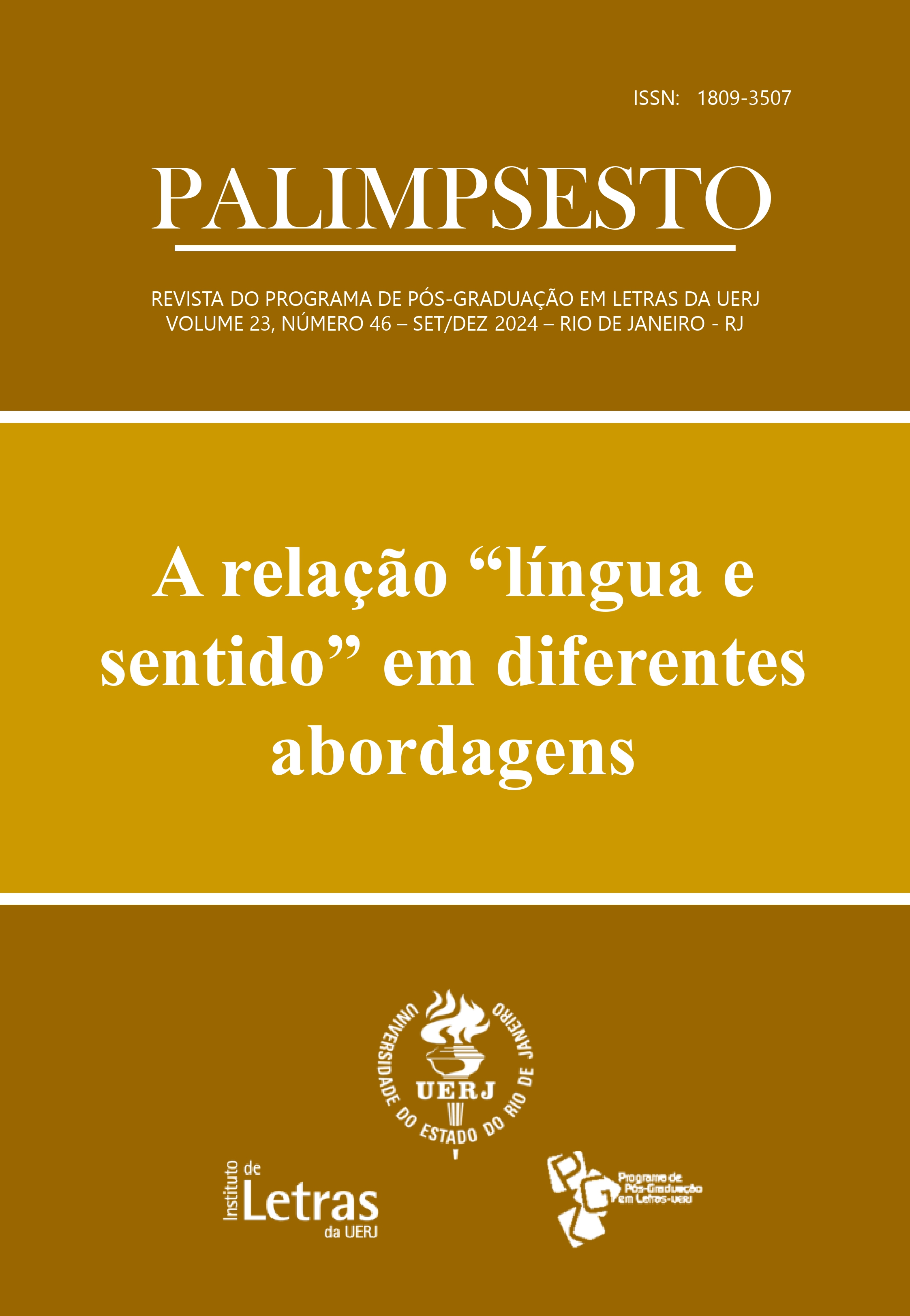Splited body - lexical-stylistic analysis of the narrator of The love of singular men, by Victor Heringer (2016)
DOI:
https://doi.org/10.12957/palimpsesto.2024.79914Keywords:
Stylistics of language, Structural stylistics, Expressiveness, Lexical choice, Victor HeringerAbstract
This study presents a lexical-stylistic analysis of the characterization of the narrator-protagonist in the novel “The love of singular men”, by Victor Heringer (2016). We begin with the correlation, suggested by Yllera (1979), between the Stylistics of Language (BALLY, 1951; CÂMARA JR., 1972; 1978) and Structural Stylistics (RIFFATERRE, 1971; 1989; GUIRAUD, 1985) for a formal approach to the literary text. Initially, we outline the concept of style and the role assigned to stylistics by these scholars. Then, we investigate the construction of expressiveness through lexical and morphosyntactic resources in the selected excerpts employing analytical categories of Lexical and Morphological Stylistics (MARTINS, 2012). Finally, we offer perspectives for interpreting the work based on the novel's style.
Downloads
References
ARAUJO, Fernando Marcial Ricci. Jamais a coisa termina: pensamento, crítica e sobrevivência na obra de Victor Heringer. 2020. 140f. Trabalho de Conclusão de Curso (Bacharelado em Psicologia) – Departamento de Psicanálise e Psicopatologia, Universidade Federal do Rio Grande do Sul, Porto Alegre, 2020.
AVULSO. In: DICIONÁRIO Eletrônico Houaiss da Língua Portuguesa. Rio de Janeiro: Instituto Antônio Houaiss, 2024. Disponível em: https://houaiss.uol.com.br/corporativo/apps/uol_www/v5-4/html/index.php#1. Acesso em: 4 abr. 2024.
BALLY, Charles. Traité de Stylistique Française. Paris: Librairie C. Klincksieck, 1951.
BITTEL, Jason. Como o rostinho fofo desse animal “mascarado” o mantém seguro. National Geographic. 2020. Disponível em: https://www.nationalgeographicbrasil.com/animais/2019/02/rostinho-fofo-animal-slow-loris-lento-java-indonesia-veneno-toxina-perigo. Acesso em: 14 dez. 2022.
CÂMARA JR., Joaquim Mattoso. Contribuição à estilística portuguesa. Rio de Janeiro: Ao Livro Técnico, 1978.
CÂMARA JR., Joaquim Mattoso. Dispersos de J. Mattoso Câmara Jr. Seleção e introdução por Carlos Eduardo Falcão Uchôa. Rio de Janeiro: Fundação Getúlio Vargas, Serv. de publicações, 1972.
CÂMARA JR., Joaquim Mattoso. História da Linguística. Tradução: Maria do Amparo Barbosa de Azevedo. Petrópolis: Vozes, 1975.
CAPENGA. In: DICIONÁRIO online Caldas Aulete. Rio de Janeiro: Lexikon Editora Digital, 2024. Disponível em: http://www.aulete.com.br/site.php?mdl=aulete_digital&op=creditos. Acesso em: 4 abr. 2024.
CAPENGA. In: DICIONÁRIO Eletrônico Houaiss da Língua Portuguesa. Rio de Janeiro: Instituto Antônio Houaiss, 2024. Disponível em: https://houaiss.uol.com.br/corporativo/apps/uol_www/v5-4/html/index.php#1. Acesso em: 4 abr. 2024.
CARDOSO, Elis de Almeida. O Léxico do Discurso Literário. São Paulo: Editora da Universidade de São Paulo, 2018.
CASTILHO, Ataliba T. de. Nova Gramática do Português Brasileiro. São Paulo: Editora Contexto, 2012.
GINZBURG, Jaime. Literatura, violência e melancolia. São Paulo: Autores Associados, 2013.
GUIRAUD, Pierre. Essais de stylistique. Paris: Éditions Klincksieck, 1985.
GUIRAUD, Pierre. La estilística. Buenos Aires: Editorial Nova, 1960.
HERINGER, Victor. O amor dos homens avulsos. São Paulo: Companhia das Letras, 2016.
MARTINS, Nilce Sant’Anna. Introdução à Estilística. A Expressividade na Língua Portuguesa. 4. ed. São Paulo: Editora da Universidade de São Paulo, 2012.
LANGLEY, Liz. É possível sentir o cheiro da fraqueza? Lêmures conseguem. National Geographic. 2020. Disponível em: https://www.nationalgeographicbrasil.com/animais/2018/07/cheiro-fraqueza-lemure-odor-mamifero. Acesso em: 14 dez. 2022.
LAPA, Manuel Rodrigues. Estilística da língua portuguesa. Coimbra: Coimbra Editora, Limitada, 1975.
LE BRETON, David. A sociologia do corpo. Petrópolis: Editora Vozes, 2007.
RIFFATERRE, Michael. A produção do texto. São Paulo: Martins Fontes, 1989.
RIFFATERRE, Michael. Estilística estrutural. Tradução de Anne Arnichand e Álvaro Lorencini. São Paulo: Cultrix, 1971.
SANHA. In: DICIONÁRIO online Caldas Aulete. Rio de Janeiro: Lexikon Editora Digital, 2024. Disponível em: http://www.aulete.com.br/site.php?mdl=aulete_digital&op=creditos. Acesso em: 4 abr. 2024.
SANHA. In: DICIONÁRIO Eletrônico Houaiss da Língua Portuguesa. Rio de Janeiro: Instituto Antônio Houaiss, 2021. Disponível em: https://houaiss.uol.com.br/corporativo/apps/uol_www/v5-4/html/index.php#1. Acesso em: 4 abr. 2024.
SELVAGEM. In: DICIONÁRIO Eletrônico Houaiss da Língua Portuguesa. Rio de Janeiro: Instituto Antônio Houaiss, 2024. Disponível em: https://houaiss.uol.com.br/corporativo/apps/uol_www/v5-4/html/index.php#1. Acesso em: 4 abr. 2024.
VANOYE, Francis. Usos da linguagem: problemas e técnicas na produção oral e escrita. São Paulo: Martins Fontes, 1991.
YLLERA, Alicia. Estilística, Poética e Semiótica literária. Coimbra: Livraria Almedina, 1979.
Downloads
Published
How to Cite
Issue
Section
License
Palimpsesto journal publishes original articles and reviews in the field of Literature, Language and Linguistics. We also publish mixed and/or thematic issues, with articles and reviews in Portuguese, English, Spanish, and French.
Authors retain copyright and grant the journal the right of its first publication, with the work simultaneously licensed under Creative Commons Attributions License, which allows sharing of the work with an acknowledgement of authorship and initial publication in this journal.

Palimpsesto uses a Creative Commons - Atribuição-NãoComercial 4.0 Internacional license.







